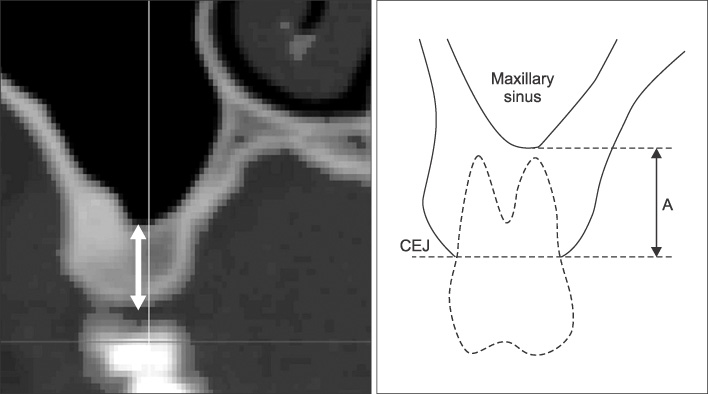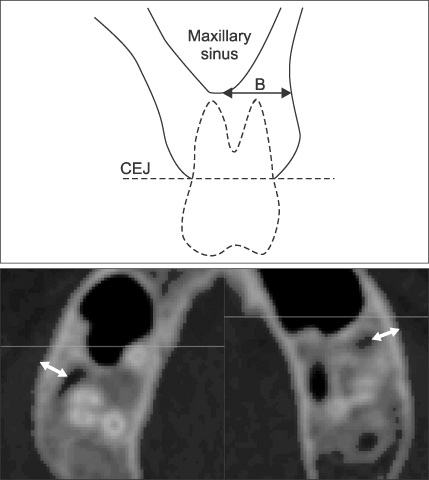Korean J Orthod.
2009 Dec;39(6):354-361. 10.4041/kjod.2009.39.6.354.
Consideration of maxillary sinus bone thickness when installing miniscrews
- Affiliations
-
- 1Department of Orthodontics, Dental Hospital, Dankuk University, Korea. kdh3873@hanmail.net
- KMID: 1975779
- DOI: http://doi.org/10.4041/kjod.2009.39.6.354
Abstract
OBJECTIVE
Miniscrews are widely used in orthodontic treatment for the purpose of anchorage control. Maximum anchorage can be acquired by the use of miniscrews. Maxillary miniscrew has many clinical advantage for orthodontic treatment. Maxillary sinus, tooth root can be an obstacle for maxillary miniscrew installation. The purpose of this study was to find the safest area and direction of miniscrew insertion in consideration of the maxillary sinus. METHODS: The maxillary sinus area of 40 patients (20 male, 20 female) was measured using 3D computed tomography and 3D reconstruction program. RESULTS: The maxillary sinus floor was located most inferiorly between the 1st molar and 2nd molar and located most superiorly between the 1st premolar and 2nd premolar. Buccal bone thickness from the maxillary sinus is significantly thicker between the 1st molar and 2nd molar and significantly thinner between the 1st premolar and 2nd premolar. The area between the 1st premolar and 2nd premolar has a significantly longer vertical distance from CEJ to sinus in consideration of buccal bone thickness. CONCLUSIONS: Considering maxillary bone thickness, the posterior area has advantages over the anterior area for installing miniscrews safely and preventing perforation.
Keyword
MeSH Terms
Figure
Cited by 1 articles
-
Comparison of palatal bone thickness between 3D model and lateral cephalometric radiograph
Min-Guk Jang, Jin-Woo Lee, Kyung-Suk Cha, Dong-Hwa Chung, Sang-Min Lee
Korean J Orthod. 2011;41(5):312-323. doi: 10.4041/kjod.2011.41.5.312.
Reference
-
1. Misch CE. Contemporary implant dentistry, chapter 8. 1999. 2nd ed. St Louis: Mosby;113.2. Wehrbein H, Merz BR, Diedrich P. Palatal bone support for orthodontic implant anchorage-a clinical and radiological study. Eur J Orthod. 1999. 21:65–70.
Article3. Henriksen B, Bavitz B, Kelly B, Harn SD. Evaluation of bone thickness in the anterior hard palate relative to midsagittal orthodontic implants. Int J Oral Maxillofac Implants. 2003. 18:578–581.4. Bernhart T, Vollgruber A, Gahleitner A, Dörtbudak O, Haas R. Alternative to the median region of the palate for placement of an orthodontic implant. Clin Oral Implants Res. 2000. 11:595–601.
Article5. Kyung SH. A study on the bone thickness of midpalatal suture area for miniscrew insertion. Korean J Orthod. 2004. 34:63–70.6. Park YC, Lee JS, Kim DH. Anatomical characteristics of the midpalatal suture area for miniscrew implantation using CT image. Korean J Orthod. 2005. 35:35–42.7. Gahleitner A, Podesser B, Schick S, Watzek G, Imhof H. Dental CT and orthodontic implants: imaging technique and assessment of available bone volume in the hard palate. Eur J Radiol. 2004. 51:257–262.
Article8. Lee KY, Lee JW. Study of miniscrew about installation position and condition on maxillary palatal side [thesis]. 2008. Cheonan: Dankook University.9. Park HS. An anatomical study using CT images for the implantation of micro-implants. Korean J Orthod. 2002. 32:435–441.10. Lee KJ, Joo E, Kim KD, Lee JS, Park YC, Yu HS. Computed tomographic analysis of tooth-bearing alveolar bone for orthodontic miniscrew placement. Am J Orthod Dentofacial Orthop. 2009. 135:486–494.
Article11. Jo HS, Lee JW. Three dimensional study of miniscrew about installation area and angle. J Korean Acad Stomatog Func Occl. 2008. 24:203–211.12. Kim BY, Kim JD. A radiographic study on the morphology of the maxillary sinus. Korean J Oral Maxillofac Radiol. 1991. 21:297–306.13. Yoon HR, Park CS. A radiologic study of the relationship of the maxillary sinus floor and apex of the maxillary molar. Korean J Oral Maxillofac Radiol. 1998. 28:111–126.14. Kim SH, Lee KB, Chung KR, Nelson G, Kim TW. Severe bimaxillary protrusion with adult periodontitis treated by corticotomy and compression osteogenesis. Korean J Orthod. 2009. 39:54–65.
Article15. Lee HA, Park YC. Treatment and posttreatment changes following intrusion of maxillary posterior teeth with miniscrew implants for open bite correction. Korean J Orthod. 2008. 38:31–40.
Article16. Kim HJ, Yun HS, Park HD, Kim DH, Park YC. Soft-tissue and cortical-bone thickness at orthodontic implant sites. Am J Orthod Dentofacial Orthop. 2006. 130:177–182.
Article17. Doud Galli SK, Lebowitz RA, Giacchi RJ, Glickman R, Jacobs JB. Chronic sinusitis complicating sinus lift surgery. Am J Rhinol. 2001. 15:181–186.
Article18. Van den Bergh JP, ten Bruggenkate CM, Disch FJ, Tuinzing DB. Anatomical aspects of sinus floor elevations. Clin Oral Implant Res. 2000. 11:256–265.
Article19. Vlassis JM, Fugazzotto PA. A classification system for sinus membrane perforations during augmentation procedures with options for repair. J Periodont. 1999. 70:692–699.
Article20. Pikos MA. Maxillary sinus membrane repair: report of a technique for large perforations. Implant Dent. 1999. 8:29–34.21. Poggio PM, Incorvati C, Velo S, Carano A. "Safe zones": a guide for miniscrew positioning in the maxillary and mandibular arch. Angle Orthod. 2006. 76:191–197.22. Choi SY, Lee SR, Koh KJ. A computed tomographic study on the size and bone wall thickness of the maxillary sinus in normal, preoperative and postoperative maxillary sinusitis patients. Korean J Oral Maxillofac Radiol. 2000. 30:109–116.
- Full Text Links
- Actions
-
Cited
- CITED
-
- Close
- Share
- Similar articles
-
- One-staged sinus bone graft using tapered porous surfaced implant in lower residual bone height of maxillary sinus
- A study on the bone thickness of midpalatal suture area for miniscrew insertion
- Morphometrics of alveolar process and anatomical structures around inferior maxillary sinus for maxillary implantation
- Assessment of the relationship between the maxillary molars and adjacent structures using cone beam computed tomography
- Analysis of the root position and angulation of maxillary premolars in alveolar bone using cone-beam computed tomography





